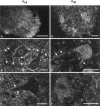Localization of Ca2+ channel subtypes on rat spinal motor neurons, interneurons, and nerve terminals
- PMID: 9698323
- PMCID: PMC6793183
- DOI: 10.1523/JNEUROSCI.18-16-06319.1998
Localization of Ca2+ channel subtypes on rat spinal motor neurons, interneurons, and nerve terminals
Abstract
Ca2+ channels in distinct subcellular compartments of neurons mediate voltage-dependent Ca2+ influx, which integrates synaptic responses, regulates gene expression, and initiates synaptic transmission. Antibodies that specifically recognize the alpha1 subunits of class A, B, C, D, and E Ca2+ channels have been used to investigate the localization of these voltage-gated ion channels on spinal motor neurons, interneurons, and nerve terminals of the adult rat. Class A P/Q-type Ca2+ channels were present mainly in a punctate pattern in nerve terminals located along the cell bodies and dendrites of motor neurons. Both smooth and punctate staining patterns were observed over the surface of the cell bodies and dendrites with antibodies to class B N-type Ca2+ channels, indicating the presence of these channels in the cell surface membrane and in nerve terminals. Class C and D L-type and class E R-type Ca2+ channels were distributed mainly over the cell soma and proximal dendrites. Class A P/Q-type Ca2+ channels were present predominantly in the presynaptic terminals of motor neurons at the neuromuscular junction. Occasional nerve terminals innervating skeletal muscles from the hindlimb were labeled with antibodies against class B N-type Ca2+ channels. Staining of the dorsal laminae of the rat spinal cord revealed a complementary distribution of class A and class B Ca2+ channels in nerve terminals in the deeper versus the superficial laminae. Many of the nerve terminals immunoreactive for class B N-type Ca2+ channels also contained substance P, an important neuropeptide in pain pathways, suggesting that N-type Ca2+ channels are predominant at synapses that carry nociceptive information into the spinal cord.
Figures







Similar articles
-
Focal aggregation of voltage-gated, Kv2.1 subunit-containing, potassium channels at synaptic sites in rat spinal motoneurones.J Physiol. 2004 Feb 1;554(Pt 3):673-85. doi: 10.1113/jphysiol.2003.056192. Epub 2003 Nov 7. J Physiol. 2004. PMID: 14608003 Free PMC article.
-
Differential localization of Ca2+ channel alpha1 subunits in the enteric nervous system: presence of alpha1B channel-like immunoreactivity in intrinsic primary afferent neurons.J Comp Neurol. 1999 Jun 21;409(1):85-104. doi: 10.1002/(sici)1096-9861(19990621)409:1<85::aid-cne7>3.0.co;2-x. J Comp Neurol. 1999. PMID: 10363713
-
Distribution of high-voltage-activated calcium channels in cultured gamma-aminobutyric acidergic neurons from mouse cerebral cortex.J Neurosci Res. 2002 Jan 1;67(1):48-61. doi: 10.1002/jnr.10074. J Neurosci Res. 2002. PMID: 11754080
-
Presynaptic excitability.Int Rev Neurobiol. 1995;38:201-51. doi: 10.1016/s0074-7742(08)60527-9. Int Rev Neurobiol. 1995. PMID: 8537201 Review.
-
Ultrastructural aspects of the coeruleo-spinal projection.Prog Brain Res. 1991;88:143-56. doi: 10.1016/s0079-6123(08)63804-2. Prog Brain Res. 1991. PMID: 1687617 Review.
Cited by
-
LRRK2 Regulates Voltage-Gated Calcium Channel Function.Front Mol Neurosci. 2016 May 23;9:35. doi: 10.3389/fnmol.2016.00035. eCollection 2016. Front Mol Neurosci. 2016. PMID: 27242426 Free PMC article.
-
Identification and characterization of novel human Ca(v)2.2 (alpha 1B) calcium channel variants lacking the synaptic protein interaction site.J Neurosci. 2002 Jan 1;22(1):82-92. doi: 10.1523/JNEUROSCI.22-01-00082.2002. J Neurosci. 2002. PMID: 11756491 Free PMC article.
-
Comparative analysis of inactivated-state block of N-type (Ca(v)2.2) calcium channels.Inflamm Res. 2011 Jul;60(7):683-93. doi: 10.1007/s00011-011-0322-9. Epub 2011 Mar 11. Inflamm Res. 2011. PMID: 21394563
-
Fetal calcium regulates branching morphogenesis in the developing human and mouse lung: involvement of voltage-gated calcium channels.PLoS One. 2013 Nov 25;8(11):e80294. doi: 10.1371/journal.pone.0080294. eCollection 2013. PLoS One. 2013. PMID: 24282533 Free PMC article.
-
Trafficking and stability of voltage-gated calcium channels.Cell Mol Life Sci. 2012 Mar;69(6):843-56. doi: 10.1007/s00018-011-0843-y. Epub 2011 Oct 2. Cell Mol Life Sci. 2012. PMID: 21964928 Free PMC article. Review.
References
-
- Appel SH, Stefani E. Amyotrophic lateral sclerosis: etiology and pathogenesis. In: Appel SH, editor. Current neurology, Vol 11. Mosby; Chicago: 1991. pp. 287–310.
-
- Appel SH, Smith RG, Engelhardt JI, Stefani E. Evidence for autoimmunity in amyotrophic lateral sclerosis. J Neurol Sci. 1993;118:169–174. - PubMed
-
- Bading H, Ginty DD, Greenberg ME. Regulation of gene expression in hippocampal neurons by distinct Ca2+ signaling pathways. Science. 1993;260:181–186. - PubMed
-
- Basbaum AI, Fields HL. Endogenous pain control system: brainstem spinal pathways and endorphin circuitry. Annu Rev Neurosci. 1984;7:309–338. - PubMed
Publication types
MeSH terms
Substances
Grants and funding
LinkOut - more resources
Full Text Sources
Other Literature Sources
Molecular Biology Databases
Miscellaneous
